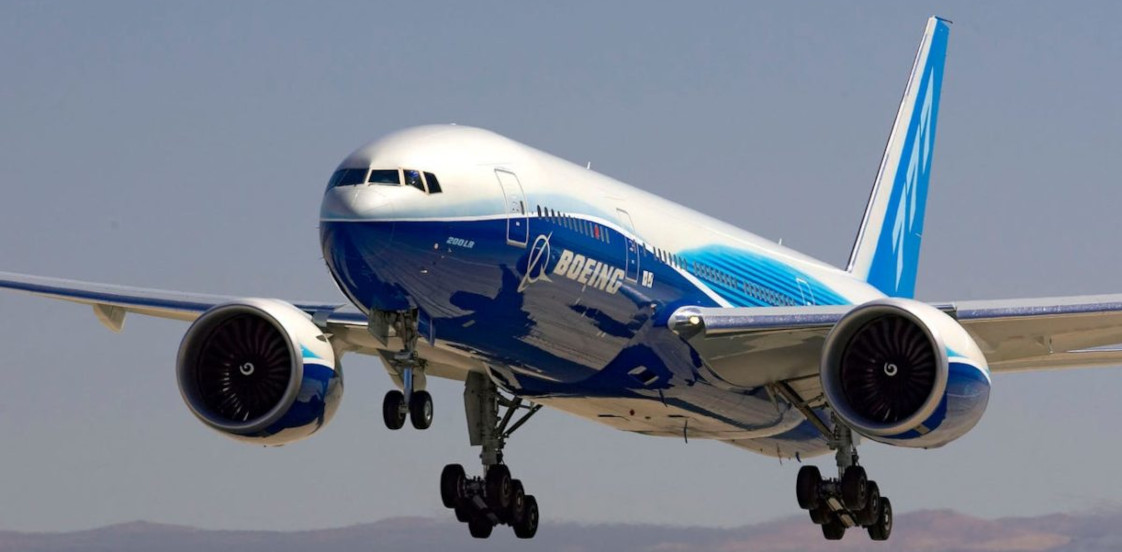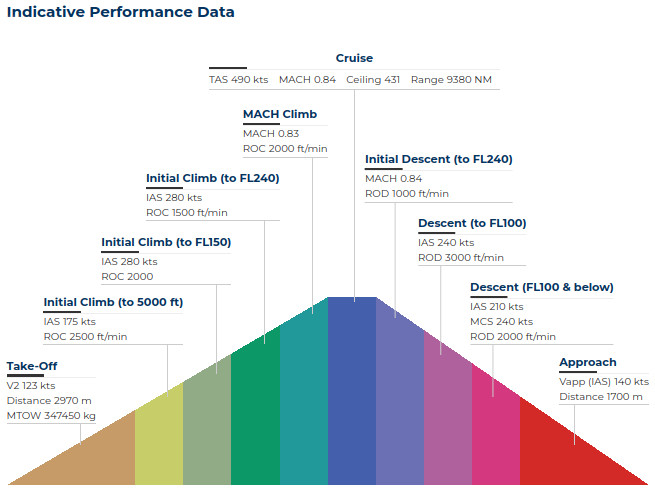
Boeing 777-200LR Overview
The 777-200LR is deservedly considered one of the most impressive and promising airliners in the history of civil aviation. The Boeing 777 200LR modification is designed for ultra-long routes. It is equipped with additional fuel tanks and has an increased maximum takeoff weight. The airliner is capable of connecting any two continents, for which it was named Worldliner. The first customer was Pakistan International Airlines.
The Boeing 777-200LR was introduced to the public in 2004 and was an expanded version of the successful Boeing 777-200ER. Its first flight took place in 2005, after which certification began. The airliner took to the skies for the first time from Paine Field airfield in Washington State, USA, and immediately attracted attention with its efficiency and outstanding range.
One of the key features of the Boeing 777 200LR is its unique range, which reaches an astounding 15,843 kilometers. This allows the airliner to fly continuously over very long distances, making it an ideal choice for long-haul flights and setting new standards in world aviation.
The aircraft is equipped with General Electric GE90-110B1L engines, which provide not only high thrust but also economical fuel consumption. This efficiency contributes to lower operating costs for airlines, making the Boeing 777-200LR very attractive in economic terms.
The Boeing 777 200LR also represents a step forward in environmental responsibility. State-of-the-art technology and engineering solutions reduce carbon dioxide emissions and ensure more efficient fuel utilization, which is relevant in the context of growing global concern for the environment.
Many major airlines choose it for their long-haul routes, recognizing its superiority in technical and commercial terms.
Development of the Boeing 777-200LR Airplane
The Boeing 777-200LR, renowned for its incredible range and technological innovation, didn’t just come into existence. Its development story is a fascinating account of the pursuit of excellence and a strategic approach to creating an airplane capable of connecting distant continents.
At the end of the 20th century, when aviation technology was becoming increasingly impressive, Boeing decided to take on the challenge of creating an airplane that would not only provide outstanding range, but also address the growing needs of global aviation. From this idea, the Boeing 777 200LR project was born.
Development began with a thorough analysis of previous models, such as the 777-200ER, to identify areas for improvement. Boeing engineers innovatively used advanced composite materials to create a lightweight yet strong structure, making the airplane more fuel efficient and durable.
One of the key components of the Boeing 777-200LR’s success has been its engines. The installation of powerful General Electric GE90-110B1L turbojet engines gave the airliner the thrust it needed for long flights, while ensuring efficient fuel consumption, an important factor for airlines.
In 2005, the Boeing 777-200LR took to the skies for the first time, capturing the world’s attention with its amazing performance. It immediately set a world record by flying 21,602 kilometers from Hong Kong to London without landing, in 22 hours and 42 minutes.
Following the successful completion of testing, the Boeing 777 200LR was introduced to the world as an efficient and future-proof aircraft. In February 2006, the airplane entered commercial service for the first time with Pakistan International Airlines, marking the beginning of a new era in long-haul air transportation.
Over time, Boeing continues to invest in improving the 777-200LR with new technologies and upgrades. Maintaining its reputation as a technical leader, Boeing demonstrates not only its ability to adapt to changing market demands, but also to learn from its experience as it strives to reach new heights in long-haul flying.
Boeing 777 200LR Technical Details
Weight
| Max. take-off weight | 322 050 — 347 800 kg |
| Max. landing weight | 220 900 — 223 170 kg |
| Empty weight | 155 580 — 156 030 kg |
| Max. weight without fuel | 206 840 — 209 110 kg |
| Max. commercial load | 50 850 kg |
| Fuel tank capacity | 202 500 L |
Flight data
| Flight range with max. load | 15 040 — 17 450 km |
| Max. cruising speed | 905 km/h |
| Maximum speed | 945 km/h |
| Ceiling (max. flight height) | 13 100 m |
| Run-up length | 2 900 m |
| Run length | 1 700 m |
| Engines | GE GE90-110B1, 2 x 49900 kgf |
Passenger compartment
| Number of seats (economy) | 440 |
| Number of seats (economy/business) | 400 |
| Number of seats (economy/business/first) | 301 |
| Cabin width | 5.87 m |

Dimensions
| Length | 63.7 m |
| Wingspan | 64.8 m |
| Height | 18.6 m |
| Wing area | 436.8 sq.m. |
Boeing 777-200LR Seat Map
The Boeing 777-200LR stands out with its impressive capacity of 314 passengers, offering a versatile range of cabin layouts tailored to meet the diverse needs of different airlines.
In a two-class configuration, passengers can experience the epitome of luxury in the meticulously designed Business Class, along with the convenience of Economy Class. Meanwhile, the three-class layout introduces Premium Economy as an intermediate level of comfort.

Business Class
Step into the Business Class, where seating is arranged in a Boeing 777-200LR seat map 1-1-1-1 layout, ensuring every passenger has ample space and easy access to the aisle. The seat, with a generous 183 cm recline, seamlessly transforms into a sleeping position. A touchscreen allows passengers to adjust their seats and access the cutting-edge in-flight entertainment system. Additional luxuries include personalized lighting options, seat-to-seat dividers, a dedicated shoe shelf, a footrest, and a personalized mini-bar.
The modern and chic design of the Business Class cabin is a testament to meticulous attention to detail. From ambient lighting to the upholstery, each element contributes to an elegant atmosphere that exudes luxury and modern sophistication. With individual climate control, lighting adjustments, and customizable seating positions, passengers can tailor their flying environment for maximum satisfaction.
Premium Economy Comfort
For those seeking a balance between Business Class indulgence and Economy Class accessibility, the 777-200LR Premium Economy Class offers extra legroom and spacious seats. The 2-4-2 seating arrangement optimizes space, with two seats on each side, four in the center, and two more on the sides. Passengers benefit from relatively easy aisle access, facilitating smooth transitions to communal areas.
Economy Class
In the standard 3-4-3 seating arrangement of the Boeing 777-200LR seat map, efficiency seamlessly combines with comfort. Economy Class seats are designed for general comfort, featuring adjustable backrests and headrests. The individual entertainment systems provide a wide array of movies, TV shows, music, and games for an enjoyable in-flight experience.
Depending on the airline, Economy Class may offer additional perks, such as pre-selected seats, complimentary beverages, or extra baggage space.
The Boeing 777-200LR redefines air travel by accommodating the preferences and needs of a diverse range of passengers. Whether reveling in the luxury of Business Class, enjoying the added comfort of Premium Economy, or experiencing the efficiency of Economy Class, every journey becomes a unique and tailored flying experience.
Comparison of 777-200LR Seat Maps
| Airline | Classes / Configuration | Total Seats |
|---|---|---|
| Air Canada Boeing 777-200LR | Business / 1-2-1, 2-2-2 Premium Economy / 2-4-2 Economy / 3-4-3 |
300 |
| Ethiopian Airlines Boeing 777-200LR | Business / 2-3-2 Economy / 3-3-3 |
315 |
| Emirates Boeing 777-200LR | First / 1-2-1 Business / 2-3-2 Economy / 3-4-3 |
266 |
| Delta Air Lines Boeing 777-200LR | Business Class / 1-2-1 Economy Extra / 3-3-3 Economy / 3-3-3 |
291 |
| Qatar Airways Boeing 777-200LR | Business / 2-3-2, 2-2-2 Economy / 3-3-3, 3-4-3 |
259,272 |

